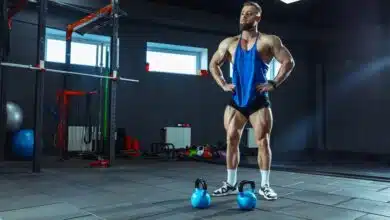Back Exercises & How to Perform Them

Back Exercises: The back is one of the most important muscle groups in the body, responsible for posture, stability, and movement. Building a strong and healthy back is crucial for overall fitness and well-being. In this article, we will discuss the best back exercises that can help you achieve a strong and well-defined back.
1. Deadlifts:
Deadlifts are one of the most effective and beneficial exercises for overall strength and muscle development. Here are some steps to perform deadlifts:
1. Start by standing with your feet shoulder-width apart and your toes pointing forward. Place your hands on the barbell with an overhand grip or mixed grip (one hand overhand and one hand underhand).
2. Bend your knees and push your hips back to lower your body down until your shins touch the barbell. Your back should be straight, and your shoulders should be slightly in front of the barbell.
3. Take a deep breath and engage your core muscles. Lift the barbell off the ground by driving your feet into the floor, straightening your knees and hips, and pulling the barbell up towards your hips.
4. Keep the barbell close to your body as you lift, and make sure your back stays straight throughout the movement.
5. Once the barbell reaches hip level, pause briefly and squeeze your glutes before slowly lowering the barbell back down to the ground.
Repeat for the desired number of repetitions.
Benefits of Deadlifts:
1. Builds strength: Deadlifts are a compound exercise that target multiple muscle groups, including your back, glutes, hamstrings, and core. By working these muscles, deadlifts help build overall strength and improve your performance in other exercises.
2. Improves posture: Deadlifts help strengthen your back muscles, which can improve your posture and reduce the risk of back pain.
3. Burns calories: Deadlifts are a full-body exercise that can help you burn calories and lose weight.
4. Increases bone density: The load-bearing nature of deadlifts can help increase bone density, which is important for maintaining healthy bones and reducing the risk of osteoporosis.
5. Boosts testosterone levels: Deadlifts have been shown to increase testosterone levels, which can help improve muscle mass, strength, and overall fitness.
2. Pull-Ups:
Performing a pull-up requires you to lift your entire body weight using only your upper body muscles, primarily your back, shoulders, and arms. Here are the steps to perform a pull-up:
1. Find a sturdy pull-up bar that can support your weight.
2. Stand underneath the bar and reach up to grab it with both hands, palms facing away from your body.
3. Hang from the bar with your arms fully extended and your feet off the ground.
4. Pull yourself up towards the bar until your chin is over it.
5. Lower yourself back down to the starting position with control.
It can take time to build up the strength to perform a full pull-up, so start by doing assisted pull-ups with a resistance band or by using a machine that provides assistance.
Benefits of Pull-ups:
Pull-ups are a challenging exercise, but they offer numerous benefits for your upper body, including:
1. Strengthening your back, shoulders, and arms: Pull-ups target multiple muscle groups in your upper body, making them an effective strength-building exercise.
2. Improving your grip strength: Holding onto the bar during a pull-up requires a strong grip, which can improve your overall grip strength.
3. Increasing your overall fitness level: Pull-ups are a challenging exercise that can improve your overall fitness level by increasing your strength and endurance.
4. Helping with posture: Strong back muscles can improve your posture and help prevent back pain.
5. Providing variety to your workout routine: Adding pull-ups to your workout routine can provide variety and help you avoid boredom.
3. Rows:
Rows are an effective exercise that primarily target the muscles in the upper and middle back, including the trapezius, rhomboids, and latissimus dorsi. There are various ways to perform rows, but the most common method involves using a barbell, dumbbells, or a cable machine. Here’s how to perform rows and their benefits:
Dumbbell Rows:
- Stand with your feet shoulder-width apart, knees slightly bent, and your back straight.
- Hold a dumbbell in each hand with an overhand grip, palms facing towards your body.
- Bend forward at the hips while keeping your back straight, and let your arms hang straight down towards the floor.
- Squeeze your shoulder blades together as you pull the dumbbells towards your chest, keeping your elbows close to your body.
- Bring the dumbbells down to the starting position and repeat again.
Benefits of Rows:
- Improved posture: Rows strengthen the muscles in your upper back, which can help improve your posture by pulling your shoulders back and down.
- Increased back strength: Rows are a compound exercise that work multiple muscles in your back, making them an effective way to increase your overall back strength.
- Reduced risk of injury: Strengthening your back muscles with rows can help reduce the risk of injury to your spine, shoulders, and neck.
- Improved sports performance: Many sports require strong back muscles, and rows can help improve your performance in activities such as swimming, rowing, and baseball.
- Balanced upper body development: Rows target the muscles in your upper and middle back, which can help balance out the development of your upper body and prevent muscle imbalances.
4. Chin-Ups:
Performing chin-ups is a great way to strengthen your upper body, especially your back and biceps. Chin-up involves the following steps:
1. Find a chin-up bar and grip it with your palms facing towards you, shoulder-width apart.
2. Hang from the bar with your arms fully extended.
3. Engage your back muscles and pull your body up towards the bar until your chin is over the bar.
4. Lower your body back down to the starting position with control.
Repeat this movement for multiple reps and sets as per your fitness level and goals.
Benefits of Chin-Ups:
Here are some of the benefits of doing chin-ups:
1. Build upper body strength: Chin-ups are a compound exercise that targets multiple muscles in your upper body, including your back, biceps, and shoulders. Doing chin-ups regularly can help build strength and muscle mass in these areas.
2. Improve grip strength: Holding onto the bar during chin-ups can help improve grip strength, which can be beneficial in other exercises and daily activities.
3. Increase functional fitness: Chin-ups are a functional exercise that mimics real-life movements, such as pulling yourself up over a wall or ledge. By performing chin-ups, you can improve your ability to perform these types of movements in daily life.
4. Boost metabolism: Chin-ups are a high-intensity exercise that can help boost your metabolism and burn calories, which can aid in weight loss and weight management.
Overall, chin-ups are a challenging but highly effective exercise that can help improve upper body strength, grip strength, and overall functional fitness.
5. Back Extensions:
Back extensions are a type of exercise that target the muscles of your lower back, glutes, and hamstrings. Here’s how to perform back extensions correctly:
1. Lie face down on a back extension bench or a mat with your hips and legs supported, and your feet secured under a foot brace.
2. Put your hands behind your head.
3. Contract your lower back muscles to lift your upper body off the bench or mat, and raise it as high as you can without straining.
4. Pause at the top of the movement and then slowly lower your body back down to the starting position.
5. Repeat again for your desired reps.
Benefits of Back Extensions:
Here are some benefits of back extensions:
1. Improved posture: Back extensions help to strengthen the muscles of your lower back, which are essential for maintaining good posture and preventing lower back pain.
2. Increased spinal flexibility: By working the muscles of your lower back, back extensions can help to increase the flexibility of your spine.
3. Stronger glutes and hamstrings: Back extensions also work the glutes and hamstrings, which are important for hip extension and overall lower body strength.
4. Improved athletic performance: Strong lower back muscles can improve your overall athletic performance, especially in activities that require a strong and stable core.
It’s important to note that back extensions should be performed with proper form and under the guidance of a qualified trainer, especially if you have a history of lower back pain or injury.
Conclusion:
In conclusion, these are some of the best back exercises that can help you build a strong and healthy back. Incorporating these exercises into your workout routine can help improve your posture, increase upper body strength, and reduce the risk of injury. It’s important to perform these exercises with proper form and to gradually increase the weight and intensity over time to avoid injury.





2 Comments